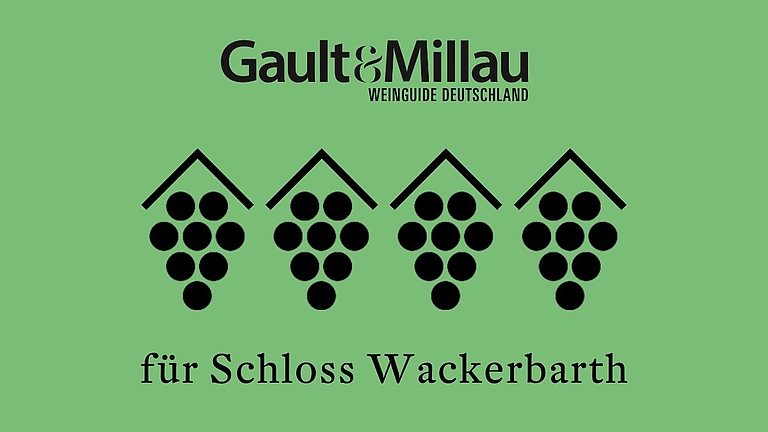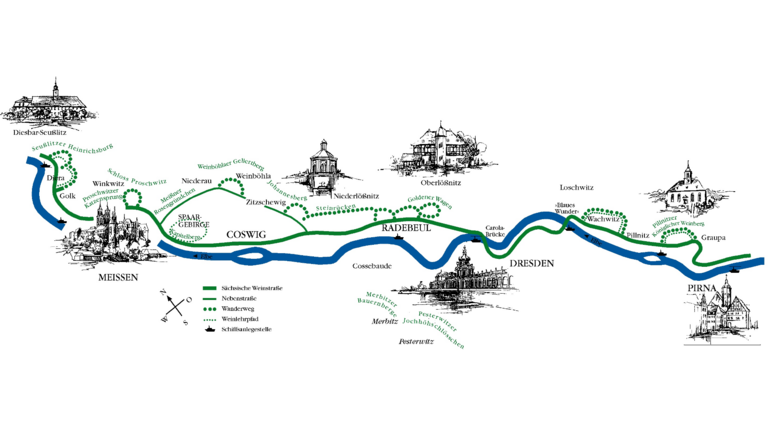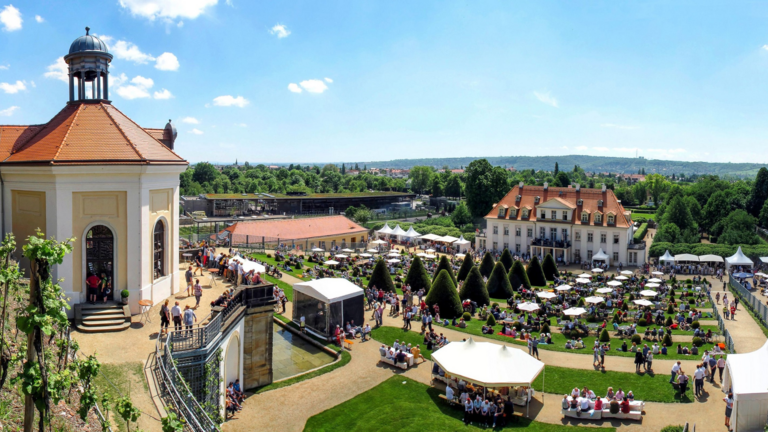Tradition and Origin
THE HISTORY OF SCHLOSS WACKERBARTH AND HOW IT BECAME EUROPE’S FIRST DESTINATION WINERY
The roots of Schloss Wackerbarth lie in the centuries-old tradition of enjoyment in Saxony's Elbe Valley: winegrowing has shaped the landscape and the lives of the people here for more than 850 years; 190 years ago, cellar masters from Reims brought the French art of sparkling wine production to Radebeul.
Our history is also closely linked to the Saxon court during the heyday of the Dresden Baroque. Between 1727 and 1730, August Christoph Count of Wackerbarth had a baroque palace and garden complex built at the foot of the Radebeul vineyards. The count was one of Augustus the Strong's closest confidants and held numerous important offices: To this day, the Field Marshal General and Privy Councillor is remembered above all as a builder - as Governor of Dresden, he is also known as the “director of the Dresden Baroque”.
It is thanks to the eventful history of the state of Saxony and our baroque estate - with more than 20 changes of ownership up to the beginning of the 20th century - that Europe's first adventure winery was established here over 20 years ago.
AN 850-YEAR WINEMAKING TRADITION
Situated on the 51st parallel, the Elbe Valley in Saxony is one of the smallest wine regions in Germany. The winegrowers here passionately cultivate around 525 hectares - only around 0.5% of the total German vineyard area. Today, only around one in every 300 bottles of German wine comes from the wine-growing region of Saxony.
Saxony's wine-growing landscape is characterized by its impressive steep slopes and terraced vineyards. These were created at the beginning of the 17th century when winegrowers from Württemberg brought terraced viticulture to the Elbe Valley. Today, they are culturally and historically significant monuments, popular tourist destinations and form the basis for the elegant wines produced by Saxony's winegrowers.
Another special feature of the wine-growing region of Saxony is the particular diversity that wine lovers can find here. Around 1,500 winegrowers, including around 1,400 leisure and hobby winegrowers - a good 20 percent of all hobby and leisure winegrowers in Germany - cultivate more than 70 different grape varieties along the Saxon Wine Route.
Schloss Wackerbarth cultivates a total of 19 grape varieties on an area of around 90 hectares. This makes us one of the largest wineries in both Saxony and Germany. The white varieties, which grow on around 80% of our vineyards, include Riesling and Müller-Thurgau, the two leading grape varieties in Saxony; Goldriesling, an elegant summer wine that is only grown by the Elbe Valley winegrowers; and a special offshoot of Traminer, which is found exclusively in our region and impresses with its floral yet delicate aromas.
Although the steep slopes and terraced vineyards of the Elbe Valley produce the best quality wines, their dry stone walls were not adequately maintained during the GDR era - i.e. for almost 50 years. This investment and renovation backlog still presents us winegrowers with challenges today and can only be resolved with great effort and not in the short term.
As the Saxon state winery, Schloss Wackerbarth has the largest share of steep slopes of all Saxon wineries - it cultivates over 20 hectares and thus around 20% of all steep slopes and terraced vineyards in Saxony and maintains a total of around 25,000 m² of dry stone walls on this area.
Wines of great elegance
In addition to the centuries-old dry stone walls, the vines in the Elbe Valley are also regularly exposed to extreme weather conditions such as winter and late frosts, hail, torrential rainfall and strong or prolonged heatwaves.
Weather-related low yields combined with above-average cultivation efforts on steep slopes are a challenge: between 2009 and 2013, Elbe Valley winegrowers lost 2.5 entire vintages and thus several million euros in sales due to extreme weather conditions. In April 2024, one of the most severe late frost events in recent decades led to a harvest loss of 75 percent of the entire vintage in just one night.
The weather-related challenges combined with the strong focus of Saxony's winegrowers on “quality over quantity” mean that Saxony has the lowest average yield of all German wine regions at 47 hl/ha. This is only about half of the German average of 90 hl/ha. Wines from Saxony are something special - a rarity.
In Saxony, the grapes continue to ripen under unique climatic conditions - favored by the prevailing influences of the continental climate, the large temperature differences between warm days and cool nights and a long ripening period. As a result, the grapes retain their distinctive aromas and natural freshness until late in the ripening process.
We press “cool climate” wines with aromatic elegance and finesse from our Saxon grapes. These are regularly recognized and awarded prizes at renowned national and international tastings such as “AWC Vienna”, “Mundus Vini” and “Best of Riesling”.
DELICACIES WITH A GREAT TRADITION
When the days get shorter and the temperatures drop, the time has come for mulled wine, glögg, grog and punch. In the search for the origins of these warming winter drinks, a trail leads back 190 years to Wackerbarth Castle in Saxony.
In December 1834, August Raugraf of Wackerbarth, a descendant of the builder of Wackerbarth Castle, stood in the wintry Belvedere. A lover of art and pleasure, he was looking for a drink that would make him forget the cold and warm his heart. So he combined white wine with all kinds of exotic spices such as saffron, aniseed and pomegranate... and had a clever idea: he warmed the liquid.
Long lost and forgotten over the years, the Raugrafen's recipe was rediscovered at the end of 2013 in the Saxon State Archives in Dresden. After a thorough examination, it was clear that it was a special recipe that would be called mulled wine today. This makes it the oldest known mulled wine recipe in Germany.
After examening the original document, we immediately began to revive this special tradition. For our “Wackerbarths Weiß & Heiß”, we have carefully adapted the historic recipe of the Raugrafen to today's tastes. The result is a delicately fruity winter drink made with Saxon grapes, grape juice and finely seasoned ingredients. Today, it is not only popular in the Elbe Valley, but also beyond the state's borders - making it a kind of ambassador for Saxony's Christmas and gourmet tradition.
Saxony has a long history of sparkling wine production following the traditional, or classic method – the original and still the most prestigious. We are grateful that more than 180 years ago, when the first champagne producers or “houses” were appearing in the Champagne region, our ancestors had the brilliant idea of establishing a sparkling wine production facility in the vineyards of Radebeul. In taking that step, they laid the foundations for one of Europe’s oldest sparkling wine traditions.
In 1836, the three highly regarded wine estate owners Ludwig Pilgrim, Georg Schwarz and Karl Friedrich Sickmann joined forces as the founders of the first facility producing mousseux in Saxony; what would become the Bussard cellars. The savvy businessmen had recognised that the grapes in Champagne and the Elbe Valley ripen under comparable climatic conditions. To this day, the two regions have a similar terroir in terms of the average temperature, the sunshine duration and annual amount of precipitation.
The founders required expertise to produce premium sparkling wines from Saxon grapes, which they found at source, in Reims: their first cellar master, Johann Joseph Mouzon, was a practised expert in sparkling wines, and introduced the French production method at the newly established facility, bringing the “traditional method” from his native land to Radebeul.
Initially, the producers used only grapes from Lössnitz and nearby areas to make their classic sparkling wines, fermented entirely in the bottle. Due to the great demand and the decline in Saxon winemaking during the 19th century, the production facility later also increasingly used grapes from other celebrated German and European wine-growing regions, such as those on the Rhine or the Mosel, or from Champagne.
The Bussard cellars became a nucleus for fine sparkling wines in Saxony. They were also a popular attraction among Saxony’s kings, who selected these tongue-tickling creations for their table and also made regular visits to the production site.
During that time, in the 1920s and 1930s, the baroque Schloss Wackerbarth and its grounds came into the hands of the Saxon State Bank when its final owner was no longer able to pay his mortgage.
Just ten years after the end of the Second World War, the Bussard cellars began producing traditional-method sparkling wine again in their own premises on Moritzburger Strasse, partly funded by the state.
In 1972, the cellars were declared the property of the “people” under Socialism. As there was limited space for growth in their old premises, in the 1970s the Bussard headquarters had to be moved to Schloss Wackerbarth. All the machinery, staff and centuries of expertise in sparkling wine were moved just a kilometre down the road to the headquarters of VEG (Z) Weinbau Radebeul, where sparkling wines had been produced on a large scale since 1958 using Eastern European base wines. The sparkling wines from Schloss Wackerbarth, however, were in short supply, available only to a select group of customers.
BECOMING EUROPE’S FIRST DESTINATION WINERY
When the Berlin Wall fell and the GDR came to an end, the baroque Schloss Wackerbarth and its grounds were returned to the Free State of Saxony in a state of dilapidation and neglect.
The newly opened borders gave East German connoisseurs their first chance to try wines from all over the world without difficulty. As a result, local winemakers lost a large chunk of their customer base during the first few years after reunification. Following the principle “noblesse oblige” and investing in their own products, during the 1990s Schloss Wackerbarth began to win back customers, though without being able to pay the high cost of renovation entirely alone.
In the second half of the 1990s, the Free State of Saxony tried to sell the entire Schloss Wackerbarth. This approach failed due to the huge amount of renovation work required and the potential buyers’ unwillingness to make investments.
To preserve Schloss Wackerbarth as an item of cultural heritage, in 1999 the Free State of Saxony decided to carry out the renovations itself and, moreover, create Europe’s first destination winery here under the aegis of the Saxon Development Bank (SAB) – and of Stefan Weber and Jochen Freiherr von Seckendorff, then members of the SAB board.
That step was connected to the Saxon state estate’s ongoing mission to preserve and promote Saxony’s vinicultural landscape, and to train apprentices to that end. The decision made Schloss Wackerbarth a trailblazer within Germany, and was an important factor in the move to secure Saxon and German winemaking’s position as a cultural asset, and preserve it in the long term.
It is a pleasure to us to see increasing numbers of wine estates in Saxony, Germany and Europe picking up the idea of a destination winery in the last 20 years, opening their doors to visitors and thus playing an active role in maintaining their local vinicultural heritage. They have recognised the promise of combining wine, new experiences and tourism.
Welcome to realm of the senses
As Europe’s first destination winery, we are a popular attraction, welcoming more than 220,000 visitors a year to our unique combination of a baroque palace and grounds, picturesque vineyards and a modern production site. Our wine estate offers an immersive experience: every day, visitors can watch the cellar master go about his work in the production facility, uncovering the secrets of winemaking and experiencing Saxony’s fine still and sparkling wines with all their senses.
We also open our doors for a variety of other functions and events, from hikes through the vineyards and culinary “wine and chocolate” or “wine and cheese” tastings to classical concerts during the Dresden Music Festival; from “Ballet at the Vineyard” and readings with Donna Leon or Ingo Zamperoni to our popular Federweisser festival or the Christmas crafts market during Advent. At Schloss Wackerbarth, art, culture and fine fare go hand in hand.
As a destination winery, we can whet guests’ appetites at bespoke functions – from conferences and corporate events to private celebrations and dream weddings.
Since it reopened as Europe’s first destination winery in 2002, Schloss Wackerbarth’s progress has been a real success story: over the past 20 years, we have dedicated ourselves to preserving Saxony’s vinicultural landscape, restructuring our vineyards and constantly improving the quality of our still and sparkling wines.
We represent Saxony’s centuries-old tradition of enjoying life’s luxuries, and today we have made it to the top of the German wine industry. Every year, we produce roughly 600,000 bottles of still and sparkling wine. Of those, some 350,000 are in the cool-climate style typical of the Saxon wine-growing region, while 250,000 bottles are sparkling wines produced using the classic method. Last year, our popular “Wackerbarth’s Weiss & Heiss” – a delicately fruity winter drink made to a historic recipe written by Count of Wackerbarth in 1834 – could be found at more than 20 carefully selected Christmas markets in eastern Germany, where we drew local wine lovers’ attention to Saxony as a wine-growing region.
To make the high quality of our products more obvious to customers, and to stay in line with what is currently considered contemporary and modern, over recent months we have revised our design with the help of the Fuenfwerken agency from Berlin. The belvedere, a historical symbol of the Saxon culture of fine fare and wines, was placed at the heart of the new look, firmly establishing it as the centrepiece of the design.
Entirely unexpectedly, but much to the delight of everyone involved, the German Design Council nominated the new look of our brand and products for the 2020 German Design Award – one of the most well-known and important design competitions in Germany. The award’s international panel of judges were also impressed by the new design, naming us a winner in the category “Excellent Communications Design. Brand Identity”.
For some years, the expert gourmets at VINUM have been presenting awards to the world’s most unique wine estates. The companies that are named “Unique Wineries of the World” have acted for decades as role models for other wine estates around the world. Their expertise has been put into practice all over the globe and their insatiable curiosity and urge to innovate have produced great wines. These are the success stories of special wine estates with time-honoured traditions, coming from Germany, Austria, Italy and France.
In February 2022, the editors presented the latest award winners and “Unique Wineries of the World” from Germany, including Schloss Wackerbarth.
“Anyone looking for a copybook case of state investment will find just that in Radebeul, near Dresden […]. [Schloss Wackerbarth] is an absolute must-see on a trip to Saxony, in part because of its extremely varied calendar [...] – all managed by a well-established, dedicated team”, the authors write.
Following extensive redevelopment and the site’s reopening as a destination winery in 2002, “a Saxon wine success story began under difficult conditions: as well as focusing on top quality, the team also had to restore the steep, centuries-old vineyards with their many terraces, and ready them for the future. That aim has already been achieved on the roughly 70 hectares of mechanically harvested vineyards, and some of the terraced vineyards. […] The trend towards environmentally friendly, sustainable winemaking has added to the complexity of the white and red wines […]. The efficient team also causes a sensation with their large quantities of sparkling wine, as can clearly be seen from the fact they were awarded the title of ‘Germany’s best sparkling wine producer – best collection’ at the VINUM 2018 German Sparkling Wine Awards. It should also not be forgotten that Wackerbarth has always played an important role in training the next generation of Saxon winemakers.”
“The best view of the baroque Wackerbarth Castle is just above Jacobstein. The best view of the estate's magnificent Riesling can be enjoyed from the picturesque terrace between the castle and the Belvedere. But Wackerbarth can do more than just baroque: the conversion to natural and sustainable viticulture has been completed, with PiWis already growing on around ten percent of the vineyard area. Wackerbarth was the first winery in the new federal states to be certified with the FairChoice seal for sustainability in the wine industry in 2023. This is best practice!”
(Gault&Millau Wine Guide Germany 2025)
With these words, the gourmet experts at Gault&Millau awarded us four grapes for the first time in December 2024, making us a top winery. Grapes and stars in wine guides are as coveted and valuable for winegrowers as stars are for chefs.
The 14 independent tasters of the Gault&Millau wine guide, consisting of top sommeliers from all over Germany, have been tasting, discussing and evaluating the submitted wines and sparkling wines “blind” since 2020. This means that the glasses are poured from covered bottles. The gourmet experts only award four grapes to wineries that they consider to be among the best in the country. With Schloss Wackerbarth and the Martin Schwarz winery in Meissen, two wineries from the Elbe Valley are now demonstrably part of this illustrious circle. The first and only ones from eastern Germany. No other winery from the two wine-growing regions of Saxony and Saale-Unstrut has yet received this great honor in Gault&Millau.

![[Translate to Englisch:] A view of the Belvedere and the Wackerbarthberg in black and white around 1965.](/fileadmin/_processed_/4/c/csm_Historie_Wackerbarth_1965_7350b809b5.jpg)

